Adjusting your glasses
Your frame must be a good fit for two reasons. Firstly, it must be comfortable and not constantly slipping down or rubbing behind the ears. Secondly, if the frame is not fitting correctly, it could affect your vision, and you won’t be able to see as well as you should.
As an online practitioner, we can’t fit your spectacles to you directly, (unless you live in Kent where we can deliver them to you at home) but we will always ensure they are set up correctly before they are sent out. You should be off to a good start if you have followed our Choosing a Frame guidelines. Your spectacles will often fit as they come and will not require further adjustments.
If they are too loose, too tight or don’t sit straight, then you have two options. You can either fit them yourself at home, which is quite a simple process or ask your local optician to fit them for you. They are generally happy to do this but may make a charge to do so.
Too loose
If your spectacles are loose, the usual solution is to shorten the sides slightly by reducing the distance between the front of the frame and the top of the bend in the arm. Usually referred to as length to bend.
To shorten the side, bend the tips firmly but gently over your fingers, as shown.

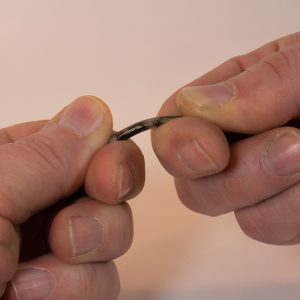

Aim for a gentle curve with a similar radius to how we supplied them, not a ninety-degree bend, as this will never be comfortable. Take it slowly in small steps until they feel snug. In most cases, you will only need to move the bend a matter of millimetres.
If you make them too tight, straighten the side out slightly and move the bend further away. Each side will not necessarily be the same length after you have finished, and the frame may no longer sit straight on a table, but this is perfectly normal. Not many people are perfectly symmetrical.
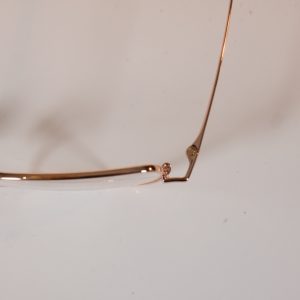
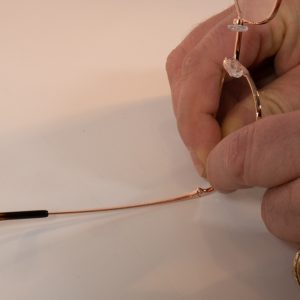

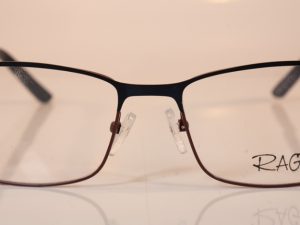
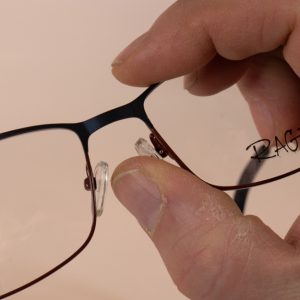
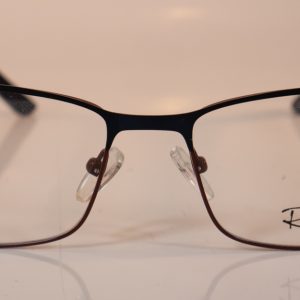
Frame sitting correctly

Frame sitting too high

Frame sitting too low

Too tight
If the frame is too tight when you receive it, look in the mirror and see how it sits. A frame that is too tight will often not rest properly on your ears. If the bend on the side starts before it will sit over your ear, you can lengthen the side by straightening it out. A plastic frame may need some heat, as above. You will then need to put the bend back in by bending it gently between your finger and thumb, as shown.
You can also move the sides further out by bending them gently where the side meets the front between finger and thumb.
Before
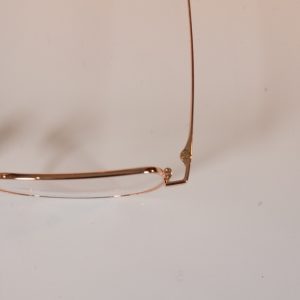
After
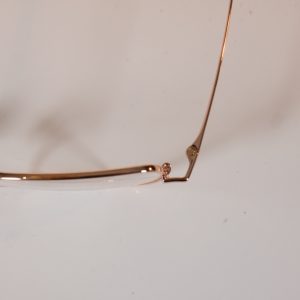
Frame not straight
If the frame doesn’t sit straight, don’t worry. Most of us have one ear slightly higher than the other, and it is simple to work out how to straighten the frame. The most important thing to work out is which way I need to move the side so it will sit correctly.
Look into a mirror. Is the frame down on the left or the right? Remember, the image is reversed.
If the frame sits too low on the right side, we can gently bring the right side down by bending it from the joint where the side meets the front. Or we could bring the left side up, and the effect will be the same. If the left side is too low, we can bring the left side down or the right side up. Or we can do a combination of the two.
Your frame will no longer sit straight on a flat surface, which is perfectly normal. Do not be tempted to adjust the frame by twisting the bridge. Although this is an easy fix, it will affect your vision. Also, ensure that the nose pads sit nicely on your nose; they are easily moved, as shown above.
Down on your left

Down on your right

Under no circumstances will Faversham Optical Ltd be held liable for any damage or injury caused by attempting to adjust your spectacles. We can not be held responsible for any charges your Optician may make for adjusting your frames.
Ongoing Maintenance
Every frame will benefit from an occasional bit of TLC. Check that all the screws are tight; if not, use a small electrical screwdriver to tighten them.
Your cloth, as supplied, should be sufficient to keep your lenses clean if used daily. Occasional washing will keep your cloth working well. We sell a range of spray cleaners that give an excellent finish, but if your spectacles get grubby, run them under a warm tap and rinse.
Dry with a cloth, tea towel or a towel, but don’t regularly use tissues or washing up liquid as these can scratch the lenses.
Please don’t use a brillo pad or kitchen pan scourer to clean your lenses; they will scratch!